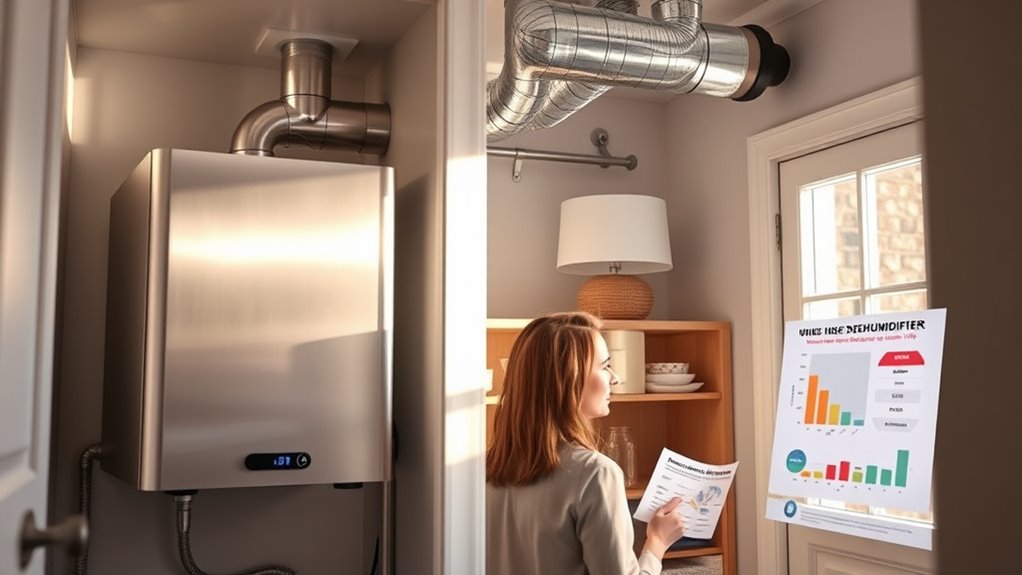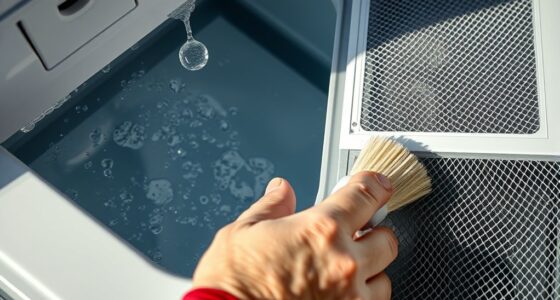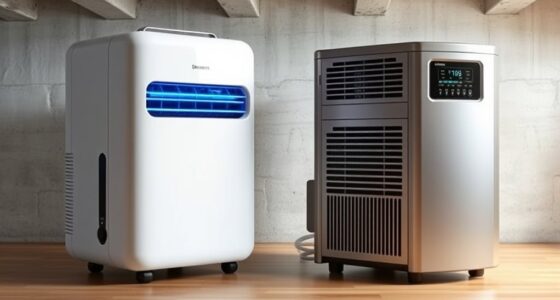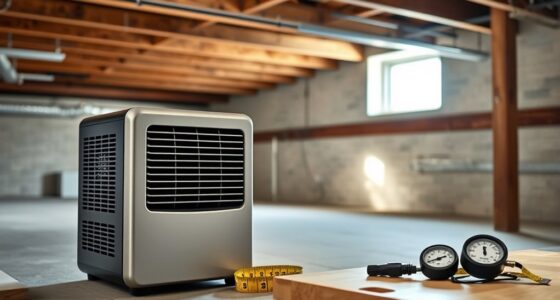Installing a whole-house dehumidifier improves comfort, protects your home, and saves energy over time. Proper planning, choosing the right size, and professional installation guarantee it works efficiently. Though initial costs vary, the long-term ROI comes from reduced mold, lower cooling bills, and healthier air quality. Keeping up with maintenance maximizes benefits. If you want to explore the best options, installation tips, and how it pays off, there’s more to learn.
Key Takeaways
- Proper sizing and professional installation optimize performance and prevent inefficiencies, ensuring a good return on investment.
- Regular maintenance, such as filter replacement and coil cleaning, extends system lifespan and maximizes long-term ROI.
- Whole-house dehumidifiers reduce energy costs by improving HVAC efficiency and preventing moisture-related damage.
- Strategic placement and system integration enhance moisture control, comfort, and overall system cost-effectiveness.
- Long-term benefits include mold prevention, improved indoor air quality, and increased home value, justifying initial installation costs.
Understanding the Benefits of Whole-House Dehumidification
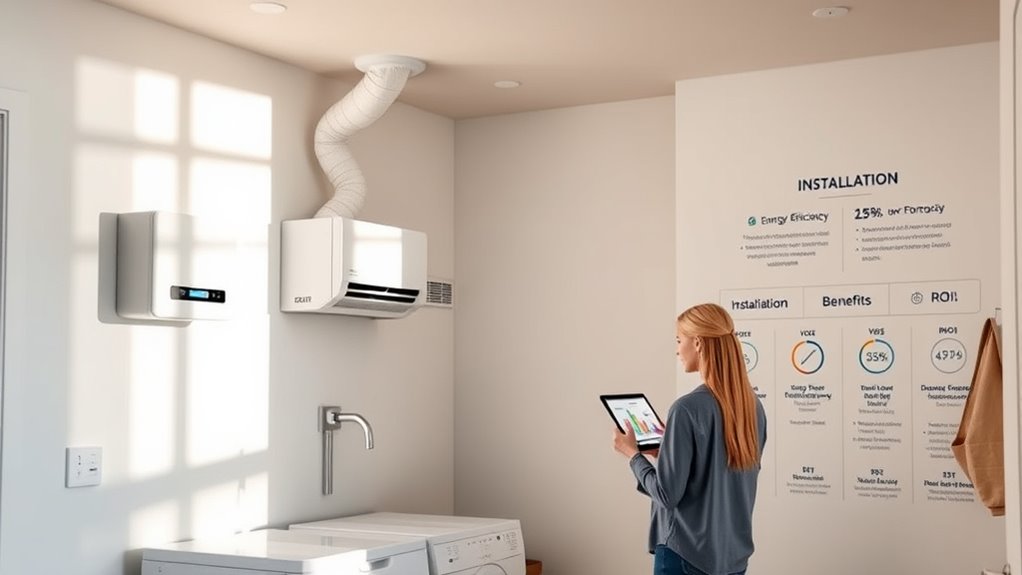
Understanding the benefits of whole-house dehumidification can markedly improve your indoor comfort and health. Proper humidity control keeps moisture levels balanced, making your home more comfortable and reducing stuffiness. It also plays an essential role in mold prevention, as excess moisture creates an ideal environment for mold growth. By maintaining ideal humidity levels, you can protect your walls, furniture, and belongings from damage caused by dampness. Whole-house dehumidifiers work silently and efficiently, providing consistent moisture control throughout your entire home. This not only enhances air quality but also reduces allergens and dust mites that thrive in humid environments. Additionally, understanding Relationships – Personality Test can help you identify and address underlying issues that may affect your home environment and your well-being. Investing in whole-house dehumidification creates a healthier, more comfortable living space, saving you money on repairs and improving your overall well-being.
Choosing the Right Dehumidifier for Your Home

Choosing the right dehumidifier for your home involves evaluating your space’s specific needs and moisture levels. Start by understanding the different dehumidifier types, such as whole-house systems versus portable units, to determine which fits your situation best. Consider the size of your home, the humidity severity, and your budget. Once you’ve identified your needs, create an installation checklist to guarantee proper setup and optimal performance. This checklist might include assessing ductwork, electrical requirements, and airflow pathways. Picking the right model means balancing capacity, energy efficiency, and features suited to your environment. Additionally, understanding Kia Tuning options can help inform your choices for optimizing performance and comfort in various settings. By carefully selecting the appropriate dehumidifier type and following a thorough installation plan, you’ll maximize your investment and enjoy healthier, more comfortable indoor air.
Planning for Professional Installation

Proper planning is essential before scheduling professional installation of your whole-house dehumidifier. You want to verify optimal indoor air quality and manage energy consumption effectively. Start by evaluating your home’s layout and humidity issues to determine the best placement. Communicate your goals clearly to the installer—whether improving air quality or reducing energy costs. Consider the system’s compatibility with your existing HVAC setup for seamless integration. Also, plan for any necessary electrical upgrades or ductwork modifications. Taking these steps helps avoid costly surprises and ensures the unit operates efficiently. For optimal results, understanding the benefits of efficient dehumidification can guide your installation choices.
Step-by-Step Installation Process
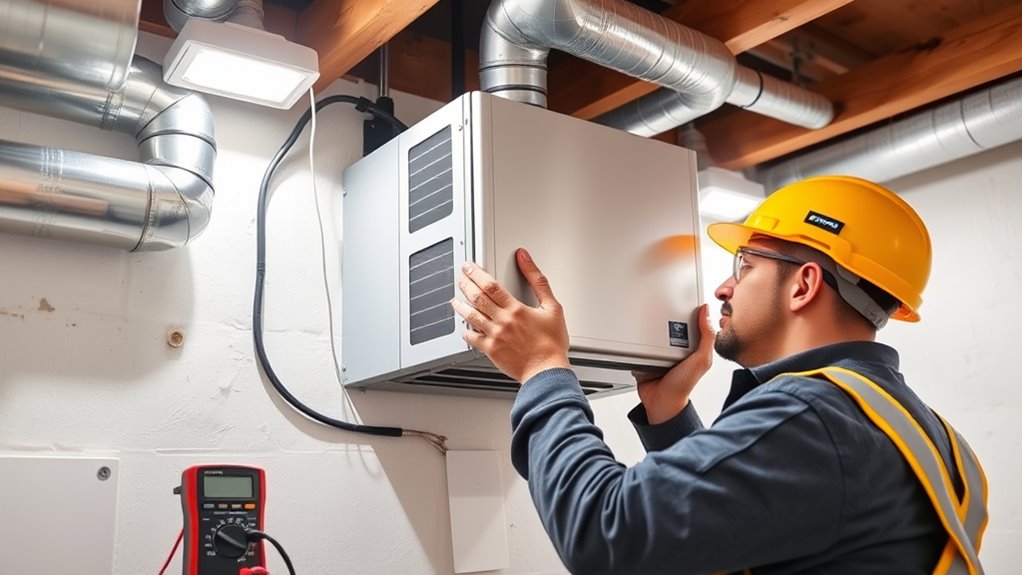
To install your whole-house dehumidifier, start by preparing the installation area, ensuring there’s enough space and proper airflow. Next, mount the unit securely according to the manufacturer’s instructions, making sure it’s level and stable. Finally, connect the electrical components carefully, verifying all connections are safe before powering it on.
Prepare Installation Area
Before installing a whole house dehumidifier, you need to prepare the installation area to guarantee a smooth process. Start by evaluating the space for proper ventilation design, which prevents airflow issues. Clear the area of clutter and obstructions to allow easy access and setup. Check that the location has adequate electrical wiring and space for duct connections. Ensure moisture barriers are in place to prevent water damage and improve efficiency. Verify the structural integrity of the chosen spot, especially if mounting on walls or ceilings. Proper preparation minimizes delays and simplifies the installation process, helping your dehumidifier operate effectively. Taking these steps ensures your system functions as intended and maximizes your investment in whole-house humidity control. Additionally, consider ventilation design to optimize airflow and system performance.
Mounting the Unit Properly
Once you’ve chosen the right spot for your dehumidifier, the next step is mounting the unit securely. Use sturdy mounting brackets designed for your model to guarantee stability. Start by positioning the brackets on the wall, following your positioning strategy to optimize airflow and drainage. Make sure the brackets are level and properly anchored into wall studs or solid anchors, not just drywall. Carefully lift the unit and align it with the brackets, then secure it firmly in place. Proper mounting prevents vibrations, noise, and potential damage. Double-check the unit’s level and stability before proceeding. A well-mounted dehumidifier ensures safe operation and easy access for maintenance, directly impacting its longevity and performance. Secure mounting is essential to prevent vibrations and ensure the unit operates efficiently over time.
Connecting Electrical Components
Connecting the electrical components correctly is essential for safe and reliable operation. Proper electrical wiring ensures the dehumidifier functions as intended and prevents hazards. First, turn off the main power before handling any circuit connections. Next, connect the dehumidifier’s power cord to a dedicated circuit, following the manufacturer’s wiring diagram. Secure all connections tightly to avoid loose wires that could cause malfunctions. Use appropriate wire nuts and electrical tape for safety and insulation. Double-check that all circuit connections are correct and grounded properly. Additionally, verifying the electrical safety standards helps prevent potential electrical hazards during installation.
Maintenance and Troubleshooting Tips
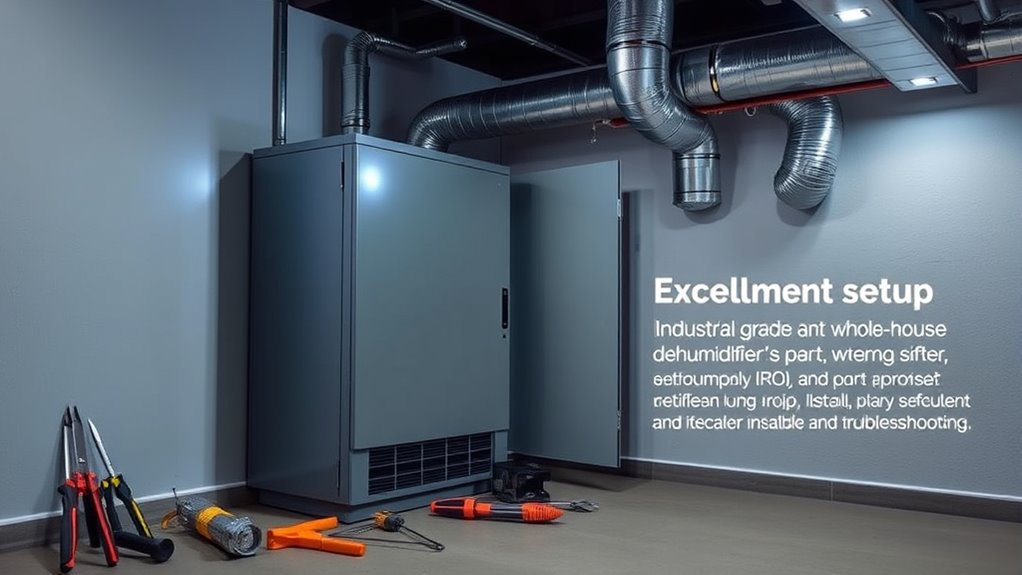
Regular maintenance is essential to keep your whole-house dehumidifier operating efficiently and prevent costly repairs. Start by checking and replacing filters regularly to ensure ideal airflow and air quality. Clean the air filters at least once every three months, or more often if you notice reduced performance. Troubleshooting common issues involves inspecting the unit for ice buildup, unusual noises, or error codes displayed on the control panel. If you experience decreased moisture removal, verify that the unit is properly connected and that airflow vents are unobstructed. Reset the system if needed, and confirm that the drain line isn’t clogged. Regularly cleaning coils and inspecting electrical connections can also prevent major malfunctions. Monitoring air quality indicators helps determine when to perform maintenance and can prevent performance decline. Staying proactive with filter maintenance and troubleshooting can extend your dehumidifier’s lifespan and keep your home comfortable.
Factors Affecting Installation Costs
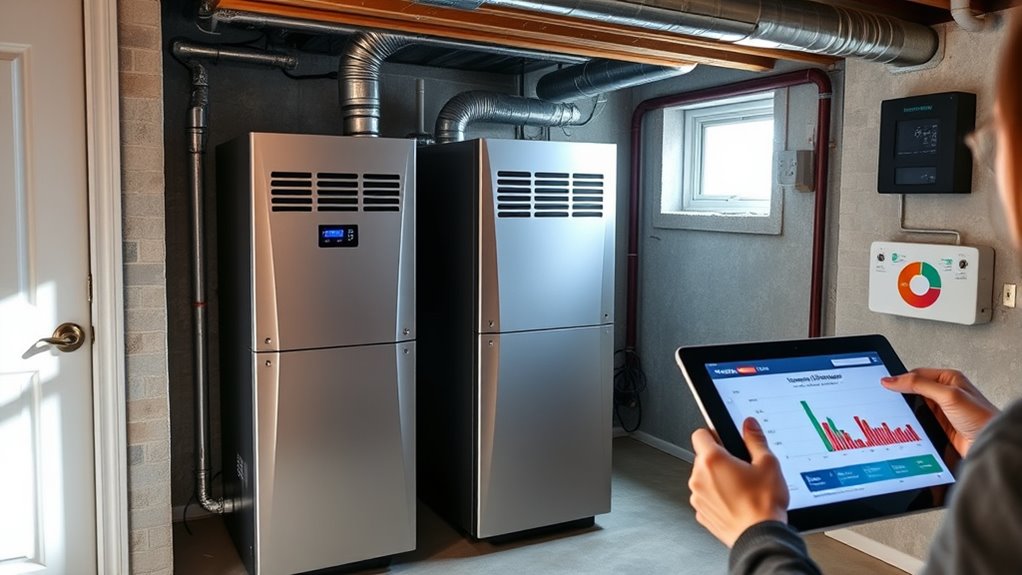
The installation cost for a whole-house dehumidifier depends on the system’s complexity and size, which can vary based on your home’s layout. Labor charges and site preparation also influence the overall price, especially if additional modifications are needed. Understanding these factors helps you anticipate what to expect and plan your budget accordingly.
System Complexity and Size
Installing a whole-house dehumidifier can vary considerably in cost depending on the system’s complexity and size. Larger units or those with more advanced features often require more extensive installation, increasing labor and equipment costs. The system complexity, such as integrating with existing HVAC systems or adding additional controls, also impacts the overall expense. Choosing a unit size that matches your home’s moisture load is essential; undersized units won’t perform well, while oversized units may be inefficient and costly. Additionally, automation technology in some systems can influence installation requirements and costs.
Labor and Site Prep
Labor and site prep can considerably influence the overall cost of installing a whole-house dehumidifier, as the complexity of your home’s existing setup determines how much work is needed. If you’re considering DIY considerations, confirm you’re comfortable with electrical work and basic carpentry, as some tasks might require professional skill. Site prep may involve clearing space, modifying ductwork, or reinforcing mounting points, which can add to labor time and costs. Material sourcing also impacts expenses—finding compatible parts or specialty fittings can delay installation or increase costs if not planned carefully. Proper planning minimizes surprises during installation, saving you both time and money. Whether you handle some tasks yourself or hire professionals, understanding these factors helps you better estimate total costs and streamline the process. Additionally, being aware of potential disadvantages of eye patches ensures you choose the most suitable skincare options for your needs.
Calculating the Return on Investment
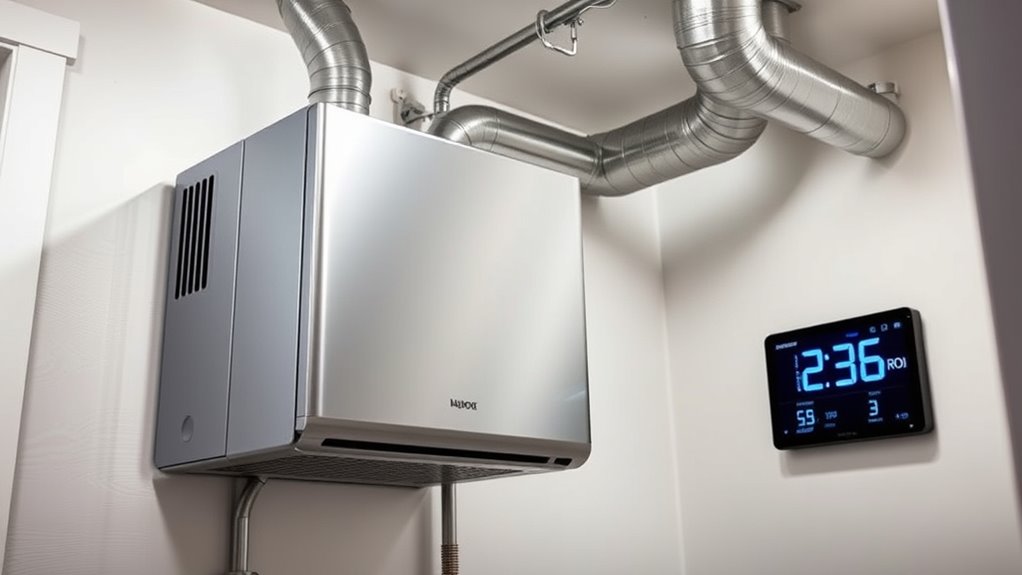
To determine whether investing in a whole-house dehumidifier makes financial sense, you need to assess the potential savings on energy bills and the improvement in indoor comfort. Conducting a thorough cost analysis helps you understand the upfront costs versus long-term benefits. Consider the investment benefits, such as reduced energy consumption, lower cooling costs, and healthier indoor air quality. You’ll want to evaluate:
Assessing cost and comfort benefits helps determine if a whole-house dehumidifier is a smart investment.
- The initial purchase and installation expenses
- Estimated energy savings over time
- Potential maintenance costs
- Increased home value or comfort
- Proper sizing and placement of the dehumidifier to ensure optimal performance and energy efficiency bicycle maintenance and setup.
Long-Term Savings and Energy Efficiency

By investing in a whole-house dehumidifier, you can considerably boost your home’s energy efficiency and enjoy long-term savings. Proper humidity control reduces the strain on your HVAC system, helping it run more efficiently and consume less energy. When humidity levels are balanced, your home maintains a more consistent temperature, which cuts down on unnecessary heating and cooling costs. Additionally, better air quality from effective dehumidification minimizes mold, dust mites, and other allergens, leading to healthier living conditions. Over time, these improvements lower your utility bills and extend the lifespan of your HVAC equipment. Implementing a dedicated dehumidification system can further optimize indoor humidity levels and maximize energy savings. Ultimately, a whole-house dehumidifier delivers ongoing savings through enhanced energy efficiency and better air quality, making it a smart investment for long-term comfort and cost reduction.
Making the Decision: Is a Whole-House Dehumidifier Worth It?

Deciding whether a whole-house dehumidifier is worth the investment depends on your home’s specific needs and climate. If you notice excess humidity, mold growth, or poor indoor air quality, a dehumidifier can make a significant difference. It helps reduce moisture levels, preventing mold and improving air quality. Consider these factors when deciding:
- Your area’s humidity levels and climate
- The presence of mold or musty odors
- Indoor air quality concerns
- The long-term benefits of mold prevention and healthier living space. Regular maintenance and proper sizing can also maximize the ROI of a dehumidifier, ensuring it operates efficiently and effectively over time.
Frequently Asked Questions
How Long Does a Typical Whole-House Dehumidifier Last?
A typical dehumidifier lifespan ranges from 5 to 10 years, depending on usage and maintenance. You’ll want to keep up with regular maintenance requirements like cleaning filters and inspecting components to extend its life. Proper care guarantees peak performance and prevents early failure. If you stay diligent with maintenance, your dehumidifier can serve you well for many years, providing consistent humidity control and protecting your home from moisture issues.
Can a Dehumidifier Be Integrated With Existing HVAC Systems?
Yes, you can integrate a dehumidifier with your existing HVAC system. To do this effectively, guarantee HVAC integration and duct system compatibility are addressed. Most whole-house dehumidifiers are designed to work seamlessly with standard ductwork, but you might need professional installation to optimize airflow and performance. This integration helps maintain consistent humidity levels and improves indoor air quality without overhauling your current system.
What Are the Common Signs Indicating a Need for Dehumidifier Installation?
Imagine noticing persistent musty odors in your home—that’s a sign you might need a dehumidifier. Mold growth is another clear indicator, especially if it appears on walls or furniture. These issues often result from excess humidity. If you see mold or smell dampness regularly, it’s time to think about installing a dehumidifier. It helps control moisture, prevents mold, and keeps your air fresh and healthy.
Are There Any Health Concerns Related to Indoor Dehumidification?
You might wonder if indoor dehumidification poses health risks, but it actually helps with allergy relief and mold prevention. Properly installed dehumidifiers reduce excess humidity, lowering mold spores and dust mites that trigger allergies. As long as you maintain your system, there’s little risk, and you’ll enjoy a healthier environment. Just guarantee your dehumidifier is correctly sized and regularly cleaned to maximize benefits and avoid potential issues.
How Does Climate Impact the Effectiveness of a Whole-House Dehumidifier?
Climate greatly impacts how effective a whole-house dehumidifier is. In humid climate zones, it helps maintain ideal humidity levels, preventing mold and discomfort. But in drier areas, it might run less often, saving energy. You’ll find it works best when humidity levels are high, especially in coastal or subtropical regions. Understanding your local climate helps you choose the right dehumidifier settings for best comfort and health.
Conclusion
Imagine your home as a lush garden, thriving in perfect balance. Installing a whole-house dehumidifier acts like a gentle rain that clears away excess moisture, leaving your space fresh and vibrant. Over time, this investment becomes a steady stream of savings, much like sunlight nurturing your garden’s growth. When you weigh the benefits, it’s clear that a dehumidifier isn’t just an addition—it’s the steady heartbeat that keeps your home’s environment healthy and harmonious.
